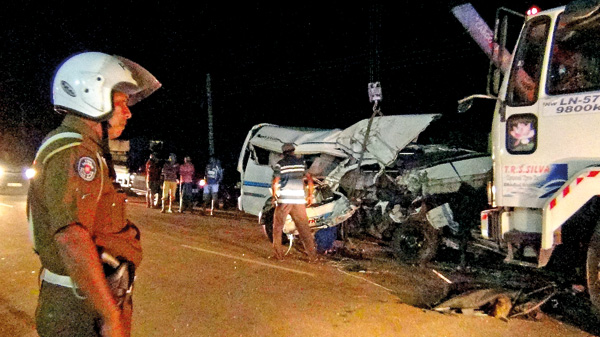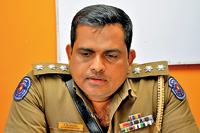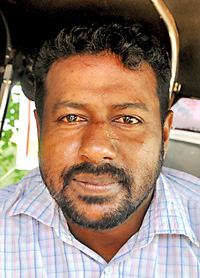News
Bottlenecks, booze, speed turn highway into death trap

The accident at Nagawilluwa. Pic by Hiran Priyankara
|
|
 Chief Inspector Anura Gunawardena |  Sub-Inspector Pathum Kumara. Pix by Priyantha Wickramaarachchi |  W. Krishantha Fernando |  Rohana Susantha Fernando |
At 1.45a.m. on Monday, a weary group of travellers refreshed themselves with a cup of tea at a café at Nagawilluwa, 125km from Colombo on the highway to Puttalam, and climbed back into their van on a dark roadside to continue their journey to Jaffna – but five of them had only minutes to live.
A tip-truck carrying clinker from Colombo to the cement factory in Puttalam crashed into a lorry parked on the road and then ricocheted across the road to smash head-on into the van, killing a pregnant mother, a child and three other passengers. Seven more travellers were injured.
The 136km stretch of road from Colombo to Puttalam has become dangerous with trucks and buses thundering along the road on tight schedules, their drivers uncaring of other vehicles and pedestrians. It is especially dangerous at night.
Puttalam police said the dead passengers were the pregnant woman, Suhardan Ahalya, Shivarajan, Sarojini, Adiyawannam Parmeshwari and Mohan Raj Lakshan.
The tip-truck driver, D.G.B. Sunimal, a resident of Chilaw, is free on Rs. 500,000 bail after having been produced in court on March 21. Puttalam Magistrate Anura Indrajith Buddadasa also ordered him to pay Rs. 50,000 to the families of the deceased for funeral arrangements.
Just a month earlier, on February 18, four people were killed outright and 19 others injured when a Colombo-bound bus from Vavuniya was partly crushed after veering off the Chilaw-Puttalam main road at Mahawewa area and slamming into a power pole bearing a heavy transformer.
Three-wheeler driver W. Krishantha Fernando, who lives nearby, said he had been woken by a thunderous sound around 3am and had gone to investigate.
“It appeared that the Vavuniya bus, which was heading towards Colombo, had swerved off the road and hit the railing of the culvert and then the power pole, which also housed the transformer,” he said.
Mr. Fernando said the transformer had fallen on the top of the bus while the front of the bus had been smashed in with the impact of hitting the power pole.
“Accidents in this road stretch are very high as buses and lorries dominate this road,” Mr. Fernando said. “They drive as if they claim the road and disregard smaller vehicles such as three-wheelers.”
He said on narrow stretches there was limited room for vehicles to veer to the edge of the road for safety when faced with fast-travelling vehicles approaching head-on.
Drivers of heavy vehicles caused most of the accidents,Chief Inspector Anura Gunawardena of the Puttalam Police confirmed.
He said bus drivers and tip-truck operators raced along the road on tight schedules.
“They compete with each other without considering the safety of pedestrians, passengers and themselves,” he said.
Inspector Gunawardena said police had deployed more officers, placed dummy images of police officers along the road, carried out educational programmes and erected boards instructing drivers to slow down.
“Accidents are taking place despite all our efforts,” he said.
Fatal accidents on the road shot up from eight in 2017 to 17 last year.
Inspector Gunawardena rejected claims that police do not take action against reckless drivers of buses and lorries.
“People don’t see our efforts – we deploy mobile bikes and teams of traffic police officers to apprehend bus and tipper drivers who exceed speed limits,” he said.
He added that police are also taking action against truck drivers – usually travelling at night – who are involved in the transport of illegally-mined sand.
Traffic police in other stations along the road acknowledged accidents were increasing along the Colombo-Puttalam road and said shortcomings in the braking systems on tipper-trucks and poor maintenance of roads increased the likelihood of accidents.
Traffic OIC Sub-Inspector Nelson Peiris of Wennappuwa police said his officers had prosecuted 200 cases of drunken driving so far this year and taken 31 drivers before the courts.
“Most private bus and tip-truck drivers are culprits: they drive recklessly and they don’t care about road signs or other motorists because they think they can intimidate everyone on the road using bulk of the vehicle,” he said
He said pedestrians and drivers of small vehicles become victims when the larger vehicles try to overtake on bends and areas that lack space for two vehicles.
“Most areas that have head-on vehicle accidents have narrowed bottleneck areas,” SI Peiris said.
The Traffic OIC at Madampe, Sub-Inspector Pathum Kumara, said two recent accidents involving heavy vehicles had occurred due to the poor condition of the road through Madampe.
In some areas the white line dividing the road had disappeared. The road was also narrow and had not been repaired for a long time.
Here, too, drink-driving was increasing: 64 cases had been prosecuted during the first three months of this year compared to 56 cases in the corresponding period last year.
The Sunday Times team also learned there was a shortage of speed guns used to detect speeding vehicles on the Colombo-Puttalam road.
It was also noticeable that police in the few stations that had speed guns were not using the devices on speeding lorries and buses and were, instead, stopping motorbikes and cars heading towards Puttalam.
A resident of Palaviya, Mohammed Nazar, also said police took action against small vehicles that travelled fast but that buses and lorries were not subjected equally to speed checks.
The Sunday Times witnessed buses and large tippers driving fast on the Chilaw-Puttalam stretch regardless of signboards warning against excessive speed.
Police officers at some stations criticised the placing of dummy images of police officers with speed guns as an impractical effort to control traffic, saying these did not fool the bus and truck drivers who plied the roads regularly and frequently.
Rohana Susantha Fernando, 46, who was maimed in a crash on this road described his frightening experience and the repercussions of that ordeal.
Mr. Fernando, a fruit seller who does business from a makeshift wooden kiosk near the Deduru Oya area, said he had been driving his small lorry to Colombo early morning on December 17 to buy goods when he became the victim of a bus speeding towards Anuradhapura via Marawila.
“I remember what happened: the bus came very fast and veered towards my lorry. I tried to swerve to the other side of the road to avoid a crash but the bus hit the right side of my lorry and dragged it along the road a few feet,” he said.
His right leg was broken in his accident, leaving him crippled.
“Doctors at the Puttalam hospital operated on me but my leg will never be the same. It is a few inches shorter due to the accident. Now I have to walk on crutches so it is difficult to move about,” Mr. Fernando said.
“The bus driver promised police that he would pay Rs. 20,000 in compensation but after being given back his licence he avoided us and has not paid the promised amount in the settlement,” the fruit-seller said.
His wife, Geetha, 38, who runs the kiosk these days following the accident, said business was difficult because customers were deterred by the speeding buses and lorries on the road.
“People are afraid to park the vehicles on the side of the road as buses and lorries drive fast, and sometimes customers travelling on the other side of the road from our kiosk give up after waiting 20 minutes or more to cross because of the speeding lorries,” she said.
People who live close to the Colombo-Puttalam main road expressed anger at the behaviour of the bus and tipper drivers.
Not our fault, it’s the brakes, say truck drivers

S.P. Ashen
Tip-truck drivers claim they cannot apply sudden brakes in an emergency because their vehicles have vacuum brakes, and say this is the reason for many accidents.
Tipper driver S.P. Ashen, 24, said in order to apply brakes he has to first gauge the distance the truck needs to go before it stops, reduce the speed of the vehicle and start braking well ahead of time.
He admitted that sometimes tipper drivers are forced to drive fast as they are given short deadlines to deliver sand or other items being transported from Colombo to Udappuwa.

Sub Inspector Nelson Peiris
“Even if we stand on our brakes the truck will not stop if we are travelling fast,” he said. “We need to consider the weight of the vehicle and the load because even if the engine stops the vehicle will move forward due to speed and weight of the vehicle.”
He admitted that there are novice truck drivers on the road as well as those aged below the age of 18 who earn a living from driving tippers. Another lorry driver said day-time tipper drivers travel slower compared to night-shift drivers, some of whom try their best to take more hires over a single night.
Wennappuwa Police Traffic Officer-in-Charge Sub Inspector Nelson Peiris confirmed that tip-trucks with heavy loads were difficult to stop as their weight dragged the vehicles forward.
Additional reporting: Hiran Piyankara JayasingheReplyForward

